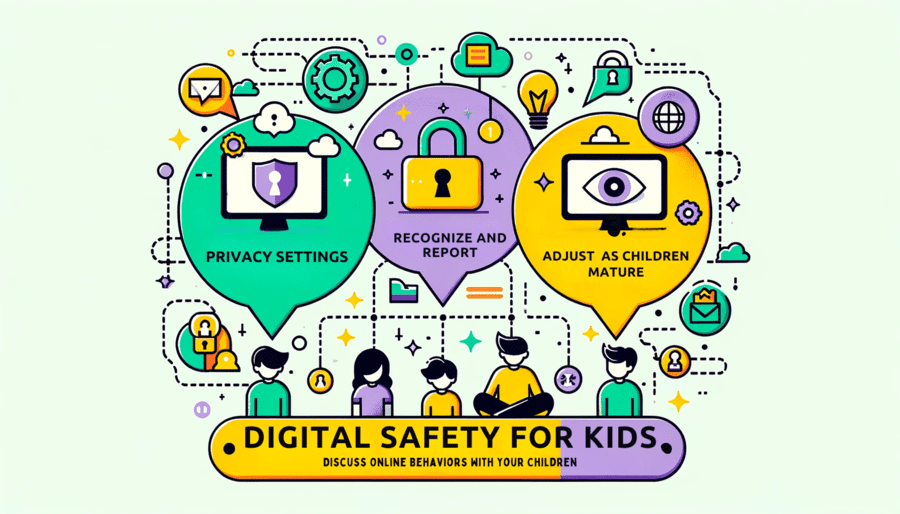Education Tips and Challenges, Parenting
How to Keep Kids Safe Online: Essential Tips and Strategies

Children are diving into the online world in the digital age earlier than ever. While it’s a realm of learning and connection, it also threatens their safety. So, how do we keep kids safe online? This article offers strategies and guidelines for caregivers to ensure a secure online experience for the young.
Key Takeaways:
- Educate children about potential online dangers and teach them safe browsing habits.
- Prioritize privacy protection and teach children to safeguard their personal information online.
- Utilize tools and resources to continually monitor and support a secure online experience for your child.
As guardians, we are responsible for guiding and educating our children on the importance of staying secure online.
The internet can overwhelm young minds, making understanding the online environment essential. Identifying potential threats and helping kids recognize them is a significant step towards promoting safer internet use. Privacy protection and practicing proper online behavior are also important factors in ensuring your child’s internet activities are safe and beneficial.
Understanding the Online Environment

The internet has become an integral part of our everyday lives, and it is important for parents and guardians to understand the online world in which their children interact. This understanding helps guide children through their various online activities, such as online games and accessing educational resources.
The online environment can consist of many websites, social media platforms, and forums where kids can communicate with others, share information, and learn new skills. However, it also presents potential risks, such as exposure to inappropriate content, cyberbullying, and privacy concerns. Hence, it is crucial to be aware of the different types of online dangers that exist to help keep children safe in their online endeavors.
One of the primary concerns regarding internet safety for kids is the vast amount of unregulated content that can be accessed. Children may inadvertently stumble across inappropriate websites, obscenities, or explicit materials while browsing the internet.
Parents and guardians can utilize parental controls and filtering software to mitigate this risk and restrict access to such content.
Cyberbullying is another significant issue in the online world, with kids potentially being targeted or even participating in harmful behaviors. It is essential to have open conversations with children about appropriate online conduct and address any instances of cyberbullying they may face or witness. Encourage them to report bullying or harassment immediately, and assure them of your support.
Online games can provide entertainment and educational value but pose risks. Many online games offer chat features that can expose children to inappropriate language or conversations with strangers. Encourage children to only interact with known friends in these games and consider disabling chat features or using games with moderated chat.
Lastly, educating children about the importance of protecting their personal information and privacy while browsing the internet is vital. Many websites and applications require personal data, leading to potential privacy breaches. Teach kids never to provide personal details or create usernames that reveal their real names to maintain their privacy and safety.
Becoming familiar with the online environment is a key step in ensuring your child’s safety on the internet. Through knowledge, guidance, and open communication, parents and guardians can help their children have a positive and secure online experience.
Recognizing Online Dangers

The Internet offers endless opportunities for learning, entertainment, and interaction. However, it also poses several risks for children if they are not properly educated about online safety. This section explores some common online dangers that parents and children must know to ensure a safe online experience.
Cyberbullying and Abuse
One of the most prevalent online dangers for children is cyberbullying. This can manifest through hurtful messages, spreading rumors, and sharing embarrassing or malicious content without consent. In many cases, cyberbullying can lead to lasting harm, including damage to a child’s mental health and self-esteem.
To counteract this threat, it is crucial for parents to teach their kids about the importance of respectful online communication and encourage them to report any abusive behavior they witness or experience.
Internet Scams and Fraud
Children may not be aware of the various scams and fraudulent schemes they may encounter online. These risks can include phishing emails, fake websites, and online identity theft. Recognizing suspicious content and protecting personal information can reduce the risk of being targeted by scammers.
Parents should explain the potential dangers of sharing personal information online and help their children identify common scams to avoid falling prey to online fraud.
Grooming and Stranger Danger
Another significant concern for parents is the risk of their child encountering predators who use the internet to groom and exploit unsuspecting victims. The anonymity provided by the internet can embolden these individuals, making it even more important for children to understand the importance of being cautious when interacting with strangers online.
To mitigate this danger, parents must emphasize the importance of not sharing personal information with strangers and should educate their children about potential signs of grooming, such as excessive flattery or attempts to isolate the child from friends and family. Regularly discussing your child’s online activity and encouraging open communication can help identify potential threats early on.
By being aware of these common online dangers and actively teaching children about internet safety, parents can help create a safe online environment for their kids to navigate.
Privacy and Personal Information

Teaching your kids about privacy and personal information management is integral to ensuring their safety online. This section will focus on maintaining privacy on social media and handling personal data.
Maintaining Privacy on Social Media
Social media platforms have become an essential part of kids’ lives today. On these platforms, they can interact with friends, share pictures, and join groups with shared interests. However, privacy should be their top priority.
- Encourage your kids to use privacy settings in their social media profiles. These settings control who can see their posts, photos, and personal information.
- Teach them to think before they post. Not everything they share online is necessary or appropriate.
- Discuss the importance of accepting friend requests only from individuals they know and trust in real life.
Handling Personal Data
Handling personal information is another crucial aspect of online safety. Ensure your kids are aware of the following tips:
- Reinforce the dangers of sharing their email address with unknown individuals or sites. This can lead to spam, phishing scams, and other threats.
- In addition to email addresses, personal data like phone numbers, home addresses, and birthdates should be kept private.
- Encourage the use of strong, unique passwords for their accounts. Weak passwords can lead to unauthorized access or even identity theft.
- Make them aware of various privacy features that may be available on their devices and applications. These features can protect their information from being accessible to others without their consent.
Educating your kids on privacy and personal information management can minimize potential risks and ensure their online experience is as safe and enjoyable as possible.
Safe Online Behavior

Setting Boundaries and Guidelines
It is crucial for parents to establish clear and consistent boundaries for their children when it comes to online activities. These guidelines should encompass the types of websites and apps they are allowed to access, the hours they can spend online, and their online privacy settings. Encourage open conversations with your child about their internet use and talk with your kids about online risks, ensuring they understand the importance of maintaining a secure online presence.
One essential aspect of establishing boundaries is teaching kids to create strong, unique passwords for their accounts. Remind them never to share these passwords with anyone except for their parents or guardians.
Additionally, stress the importance of not disclosing personal information on social media or online forums such as addresses and phone numbers.
Developing Positive Digital Habits
Parents should emphasize the development of positive online habits. Being a positive role model in your own online activities can help teach your child responsible and empathetic online behavior. Encourage your child to be kind and supportive, sending uplifting messages or emojis to friends and family.
One effective technique to help children develop healthy digital habits is monitoring their online activities. Using parental controls and privacy settings on devices, apps, and games can be helpful, as well as educating kids to use social networking sites safely. It is important to foster trust with your child so they feel comfortable discussing their online experiences and concerns with you.
Developing a sense of empathy in children is paramount for creating a safe online environment. Teach them to put themselves in others’ shoes and consider the effects of their online actions. Nurturing positive digital habits will protect children and contribute to a more positive and respectful online community.
Tools for Online Safety
Parents can use various tools to ensure their children’s online safety. One such tool is parental controls, which can be found on devices such as smartphones, tablets, and computers. These controls allow parents to monitor and restrict their child’s internet usage.
This includes limiting access to certain websites, setting up filtering software, and managing privacy settings to protect personal information.
Managing Screen Time
Balancing screen time is an integral part of online safety. Excessive device usage can lead to health issues, diminished social skills, and decreased academic performance. Parents can establish screen time guidelines, such as setting daily limits or designating device-free zones at home.
Several software options can help parents monitor their children’s screen time. Using these tools, parents can track how long their kids use devices and ensure a healthy balance of online and offline activities.
Teaching Kids about Online Safety
Teaching kids about online safety is essential for keeping them protected. Parents and guardians must play an active role in helping them learn and stay alert of potential dangers.
Age-Appropriate Guidelines
For younger kids, parents should maintain direct oversight of their internet usage. This can include:
- Monitoring browsing history
- Limiting social media usage
- Filtering inappropriate content
- Controlling screen time
As kids grow older, parents can gradually allow more independence while still keeping a watchful eye. Encourage open and honest conversations about their online experiences. Teach them about the importance of internet safety and the potential risks associated with reckless behavior.
Sex Education and Internet Safety
Kids should be aware of the sensitive nature of discussing intimate topics online and the risks associated with sexting – an activity that could lead to harassment or bullying. Explain the significance of:
- Stranger danger – The potential threat of interacting with strangers online and how this can apply to people pretending to be their age or manipulating them.
- Limiting personal information shared – Ensuring kids understand that sharing personal or sensitive details should be avoided.
- Privacy – Reinforcing the importance of safeguarding their privacy and being cautious with shared content online.
By actively teaching and engaging with kids about online safety, parents can foster a safe and positive digital environment, as well as minimize potential risks associated with internet usage.
Impact of Online Activities
Impact of Social Media and Screen Time
The online world has become an integral part of children’s lives, with social media, advertising, chat rooms, and social networking playing a significant role in their daily activities. Prolonged screen time affects their mental and physical health and can lead to sedentary lifestyles, increased risk of obesity, and sleep disturbances.
Social media platforms are filled with diverse content, including advertising that targets young audiences, often promoting unhealthy products or behaviors.
Moreover, the omnipresence of social media influencers can shape children’s views, beliefs, and aspirations, sometimes causing unrealistic expectations and self-esteem issues.
Online Experiences and Mental Health
The impact of online experiences on mental health cannot be ignored.
Children and adolescents are vulnerable to cyberbullying, leading to anxiety, depression, and even suicidal thoughts. The anonymity of chat rooms and social networking sites makes it easy for individuals to harass and intimidate others without taking responsibility for their actions.
Besides, the nature of social media encourages an environment where people seek constant validation through likes, shares, and comments. This dependency on external affirmation can harm a child’s self-worth, leading to feelings of inadequacy or depression.
Handling Technology during Home Schooling
The need for technology during homeschooling has also brought challenges when it comes to online safety. Supervising your child’s internet usage can be more difficult during school hours. It’s important to develop an online safety plan that includes establishing guidelines, spotting red flags, and monitoring children’s profiles and posts.
Some helpful strategies for implementing safety measures during homeschooling include:
- Utilizing built-in parental control features on devices
- Employing content filters for search engines and websites
- Encouraging open communication between children and parents about online issues
- Monitoring downloads and installations of new apps
- Ensuring safe and secure Wi-Fi connections
By taking these precautions, parents can help minimize the risk of potential dangers during this increased reliance on technology. Remember, knowledge is power. Being informed about the potential risks will enable you to protect better and guide your child in the digital world during this unique time.
Frequently Asked Questions
What strategies can be used to protect children from inappropriate content?
One effective strategy is to educate children about the dangers of the internet and set clear boundaries for their online activities. Communicate with them about the importance of privacy and personal information protection. Additionally, using parental control software can help block inappropriate websites and filter content.
How can parents monitor their child’s social media usage?
Parents should be aware of the platforms their children use and discuss the risks associated with social media. Encourage open communication and set rules for the use of social media. Some parental control tools also offer social media monitoring features, which allow parents to track their child’s online activities.
What are some guidelines to ensure online safety for teens?
Teens should be encouraged to think before posting and avoid sharing personal information, such as their location, full names, or contact details. They should also be aware of the risks of engaging with strangers online. Educating them about cyberbullying and reporting harmful online behavior can help ensure their safety.
What measures can teachers take to ensure students’ internet safety?
Teachers can integrate internet safety education into their lesson plans and teach students about the risks and benefits of using the internet. By showcasing examples of safe and responsible online behavior, teachers can guide students on using the internet responsibly and safely.
How can parental controls be utilized for kids’ online security?
Parental controls can be used to limit screen time, filter inappropriate content, and monitor children’s online activities. Setting up content filters and blocking specific websites can protect children from accessing dangerous online content. Parents should also maintain an open dialogue with their children about their online experiences and remind them that parental controls are in place for their safety.
What tips can help maintain a 12-year-old’s safety on the internet?
Encourage a 12-year-old to communicate openly about their online interests and activities. Ensure that they understand the importance of privacy and the risks associated with sharing personal information. Use parental control tools to monitor their internet use and limit access to age-appropriate content. Teach them to report unsafe online situations and never to agree to meet someone they encounter online without a parent’s supervision.
Wrapping Up How to Keep Kids Safe Online
The digital landscape is vast and filled with both wonders and pitfalls. As the guardians of the next generation, it’s our responsibility to arm our children with the knowledge and tools they need to navigate the internet safely.
By maintaining open communication, staying informed about online threats, and setting clear boundaries, we can ensure that our children reap the benefits of the online world without falling victim to its hazards. Let’s pledge to keep our kids safe online, fostering a space where learning, exploration, and connection can flourish without compromise.
Keeping our kids safe online is one of the many responsibilities that come with the complexities of parenting. To further understand these intricate family dynamics and their role in our decision-making processes, read our article Exploring the Complex World of Family Dynamics.
